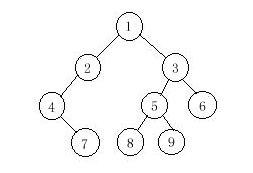原题链接: http://acm.hdu.edu.cn/showproblem.php?pid=1710
一:原题内容
Problem Description
A binary tree is a finite set of vertices that is either empty or consists of a root r and two disjoint binary trees called the left and right subtrees. There are three most important ways in which the vertices of a binary tree can be systematically traversed or ordered. They are preorder, inorder and postorder. Let T be a binary tree with root r and subtrees T1,T2.
In a preorder traversal of the vertices of T, we visit the root r followed by visiting the vertices of T1 in preorder, then the vertices of T2 in preorder.
In an inorder traversal of the vertices of T, we visit the vertices of T1 in inorder, then the root r, followed by the vertices of T2 in inorder.
In a postorder traversal of the vertices of T, we visit the vertices of T1 in postorder, then the vertices of T2 in postorder and finally we visit r.
Now you are given the preorder sequence and inorder sequence of a certain binary tree. Try to find out its postorder sequence.

In a preorder traversal of the vertices of T, we visit the root r followed by visiting the vertices of T1 in preorder, then the vertices of T2 in preorder.
In an inorder traversal of the vertices of T, we visit the vertices of T1 in inorder, then the root r, followed by the vertices of T2 in inorder.
In a postorder traversal of the vertices of T, we visit the vertices of T1 in postorder, then the vertices of T2 in postorder and finally we visit r.
Now you are given the preorder sequence and inorder sequence of a certain binary tree. Try to find out its postorder sequence.

Input
The input contains several test cases. The first line of each test case contains a single integer n (1<=n<=1000), the number of vertices of the binary tree. Followed by two lines, respectively indicating the preorder sequence and inorder sequence. You can assume they are always correspond to a exclusive binary tree.
Output
For each test case print a single line specifying the corresponding postorder sequence.
Sample Input
9 1 2 4 7 3 5 8 9 6 4 7 2 1 8 5 9 3 6
Sample Output
7 4 2 8 9 5 6 3 1
二:分析理解
题意:根据前序和中序写出后序 前序:1 2 4 7 3 5 8 9 6 中序:4 7 2 1 8 5 9 3 6 求出后序:7 4 2 8 9 5 6 3 1
首先得知道是如何前序遍历、中序遍历、后序遍历的,自己上网查下,我在这里就不多说了
思路:第一步:根据前序可知根节点为1;第二步:根据中序可知4 7 2为根节点1的左子树和8 5 9 3 6为根节点1的右子树;第三步:递归实现,把4 7 2当做新的一棵树和8 5 9 3 6也当做新的一棵树;第四步:在递归的过程中输出后序。
三:AC代码
#define _CRT_SECURE_NO_DEPRECATE
#define _CRT_SECURE_CPP_OVERLOAD_STANDARD_NAMES 1
#include<iostream>
#include<algorithm>
using namespace std;
int t1[1005];
int t2[1005];
void Func(int a, int b, int n, int flag)
{
if (n == 1)
{
printf("%d ", t1[a]);
return;
}
else if (n == 0)
return;
int i = 0;
for (; t1[a] != t2[b + i]; i++);
Func(a + 1, b, i, 0);
Func(a + i + 1, b + i + 1, n - i - 1, 0);
if (flag == 1)
printf("%d", t1[a]);
else
printf("%d ", t1[a]);
}
int main()
{
int n;
while (~scanf("%d", &n))
{
for (int i = 1; i <= n; i++)
scanf("%d", &t1[i]);
for (int i = 1; i <= n; i++)
scanf("%d", &t2[i]);
Func(1, 1, n, 1);
printf("\n");
}
return 0;
}
#define _CRT_SECURE_NO_DEPRECATE
#define _CRT_SECURE_CPP_OVERLOAD_STANDARD_NAMES 1
#include<iostream>
#include<algorithm>
using namespace std;
struct Node
{
int data;
Node* pLeft;
Node* pRight;
Node(int _data) :data(_data) { pLeft = pRight = nullptr; }
};
Node* root;
int N;
int a[1005];
int b[1005];
Node* create(int t1,int t2,int num)
{
Node* p = nullptr;
for (int i = 0; i <num; i++)
{
if (a[t1] == b[t2+i])
{
p = new Node(a[t1]);
p->pLeft = create(t1+1,t2,i);
p->pRight = create(t1 + i + 1, t2 + i + 1, num - i - 1);
return p;
}
}
return p;
}
void postOrder(Node* p)
{
if (p == nullptr)
return;
else
{
postOrder(p->pLeft);
postOrder(p->pRight);
if (p == root)
printf("%d\n", p->data);
else
printf("%d ", p->data);
}
}
int main()
{
while (~scanf("%d", &N))
{
for (int i = 0; i < N; i++)
scanf("%d", &a[i]);
for (int i = 0; i < N; i++)
scanf("%d", &b[i]);
root = create(0, 0, N);
postOrder(root);
}
return 0;
}
参考博客链接: http://www.cnblogs.com/jiangjing/archive/2013/01/14/2860163.html






















 651
651

 被折叠的 条评论
为什么被折叠?
被折叠的 条评论
为什么被折叠?








